July 18, 2022
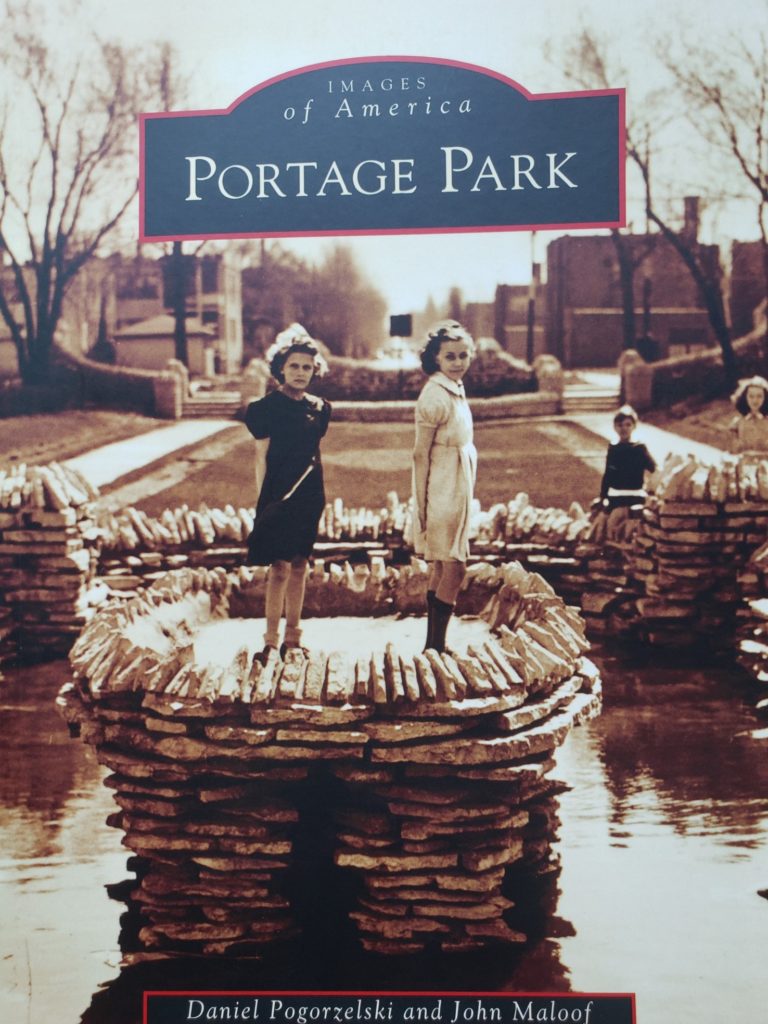
Most of you are probably familiar with or own a copy of this book. It contains numerous interesting and historic photos of the Portage Park area. In my opinion, the most significant and extraordinary photo is the aerial panorama photo of the Dickinson farm/land – our subdivisions (see below). If you ask to see what our neighborhood looked like “in the beginning”, well, there you have it!
And, if you are like me, probably one of the things you did when you saw this photo in the book was to try to get your bearings on where things are and what they are. (Where is my house in this picture?) The photo caption does help to a certain extent. Magnifying glass in hand, I’ve pored over the photo, only to get a bit frustrated. It’s a photo reproduced in a book so the quality leaves a lot to be desired in terms of good details. And damn, the spine of the book runs right through the middle of the image. A better copy of the image is needed to really analyze it.
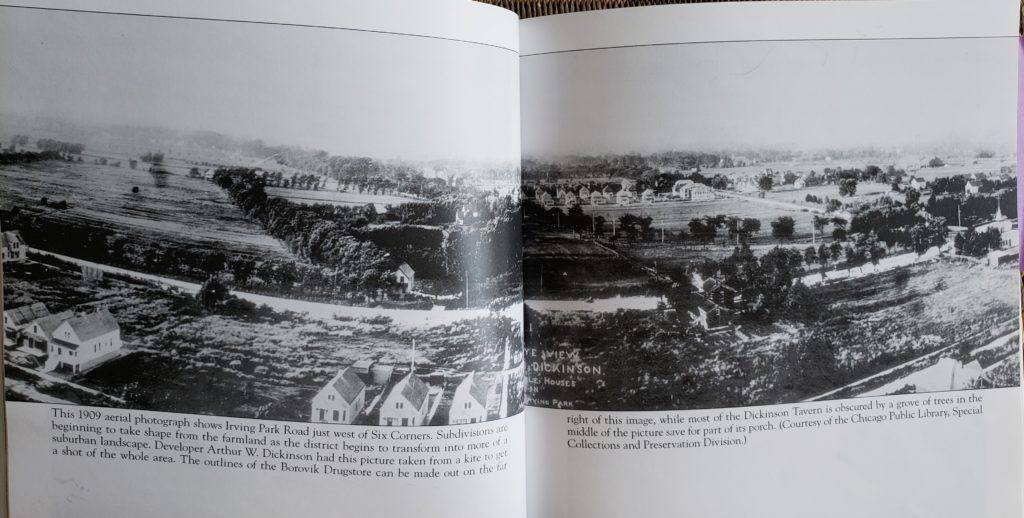
I also had to question the statement in the caption that the picture was taken from a kite. That sounded a bit far fetched to me. A manned hot air balloon, maybe, but how on earth could a kite hoist the weight of a camera, especially the types available in 1909? Yes, the lightweight consumer grade Brownie was invented around 1900 but it was not able to take a panorama photo and how would you compose the shot and trip the shutter anyway? What is the source of information that it was taken from a kite? Urban legend? Another one of those anecdotes that ultimately get debunked?
So, as usual, I started a whole new journey of investigation…
DRONES OF THE 1900’s
It didn’t take long to find articles related to aerial photography from around the turn of the century and the “technologies” that were used. Apparently, photographing from airplanes was still not feasible. Yes, hot air balloons were used, but, to my surprise, aerial photography using kites was actually a “thing”. Various photographers devised ways of accomplishing this, several of whom worked in the Chicago area. One of the most notable was a photographer named George R. Lawrence, who also built his own camera in order to take panoramic photos. Lots of examples of these aerial panoramic photos by various photographers are available on the Library of Congress web site. George Lawrence, for example, was most noted for his aerial images taken in 1906 of the aftermath of the San Francisco earthquake.
Indeed, our Arthur W. Dickinson Reliable Homes photo could have been taken from a kite. I did want more proof, though. And, who would have taken this picture, and how?
In the meantime…
It’s mid-January 2022, I’ve just made my first solid contact with an AWD descendant, Bennett, AWD’s great-grandson, and Bennett graciously begins to share some photos with me – one of which is the AWD panorama! Now I had something decent to work with. The image is still a bit fuzzy in places, and areas that I would like to see more details are still not clear. What do I expect, though? The photo was taken in 1909, after all – from a kite, no less. So, actually, the quality is incredible.
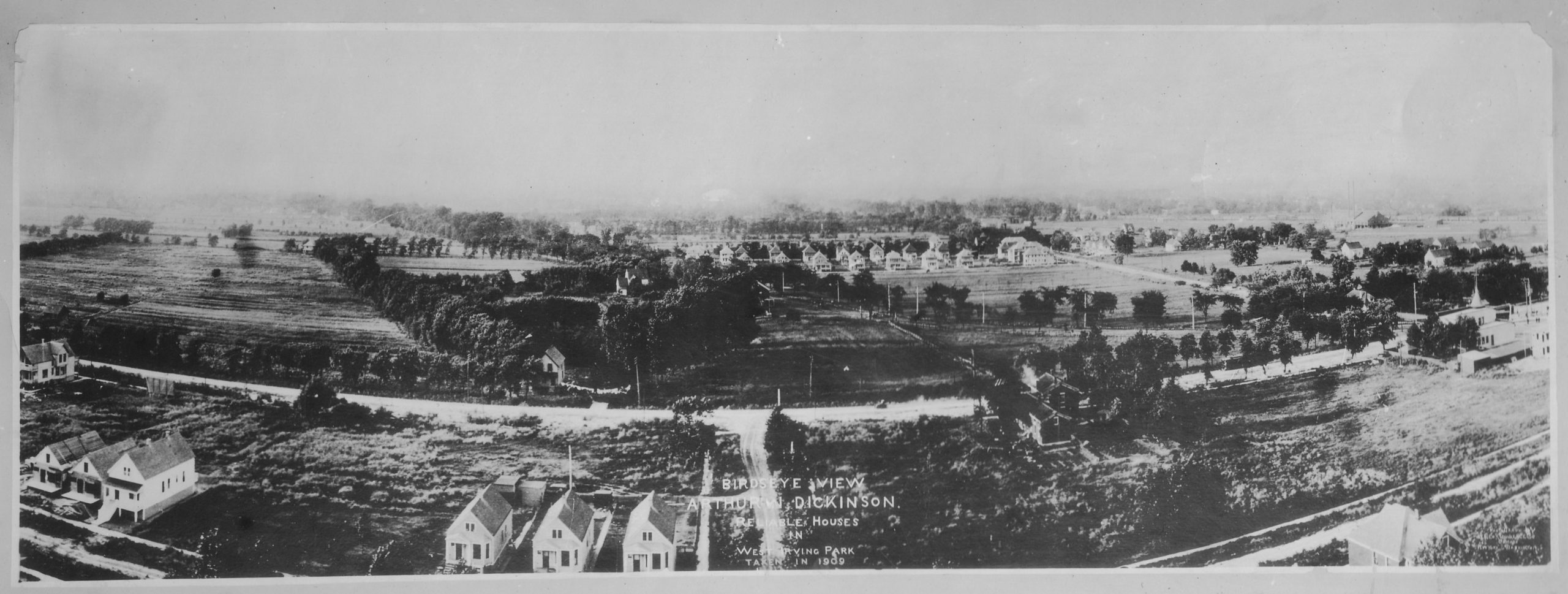
Using this version of the image and using all of the research that I’ve done to this point (particularly building permits) I created this heavily annotated copy of the photo.
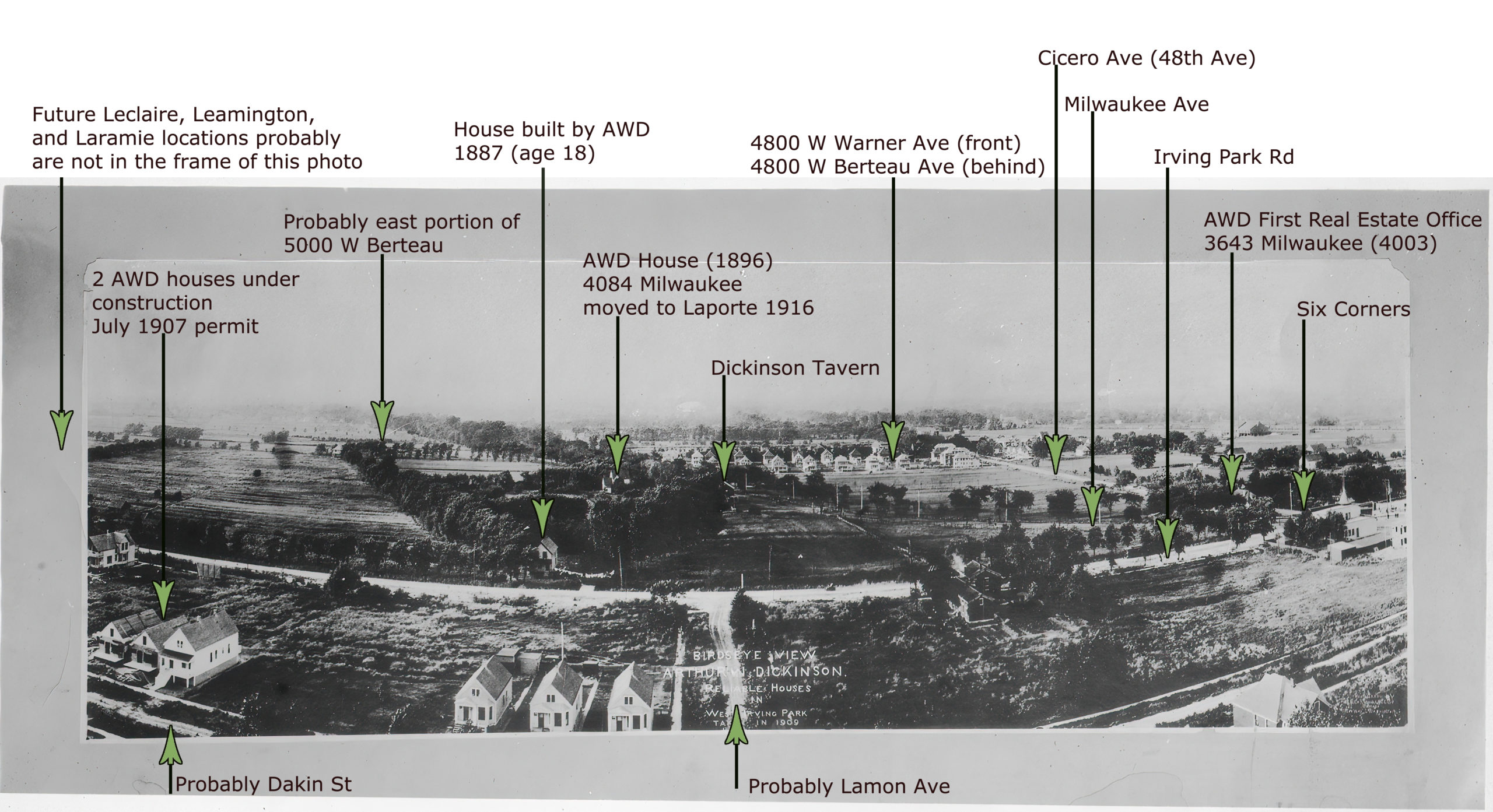
Another “in the meantime…”
During the visit to Chicago in February of 2022 by two of AWD’s descendants, David (great-grandson of AWD) was FaceTiming on the phone with his dad, David (grandson of AWD) while we were talking about this aerial panorama photo. And during that call, the following photo arrived via email from David’s mom. I would have to say that this is an original contact print from the time that the photo was taken. Looking at the feet of the person taking the picture of the picture, we can see the print is quite large. Hoping to be able to see a lot more detail on an image of this size, it was disappointing to find that the photo is quite damaged. Despite reaching out to the extended Dickinson family, another full size original image has not been found.
But wait, what do I see in the lower right corner? There seems to be some writing that is not really visible on the smaller versions of the photo.
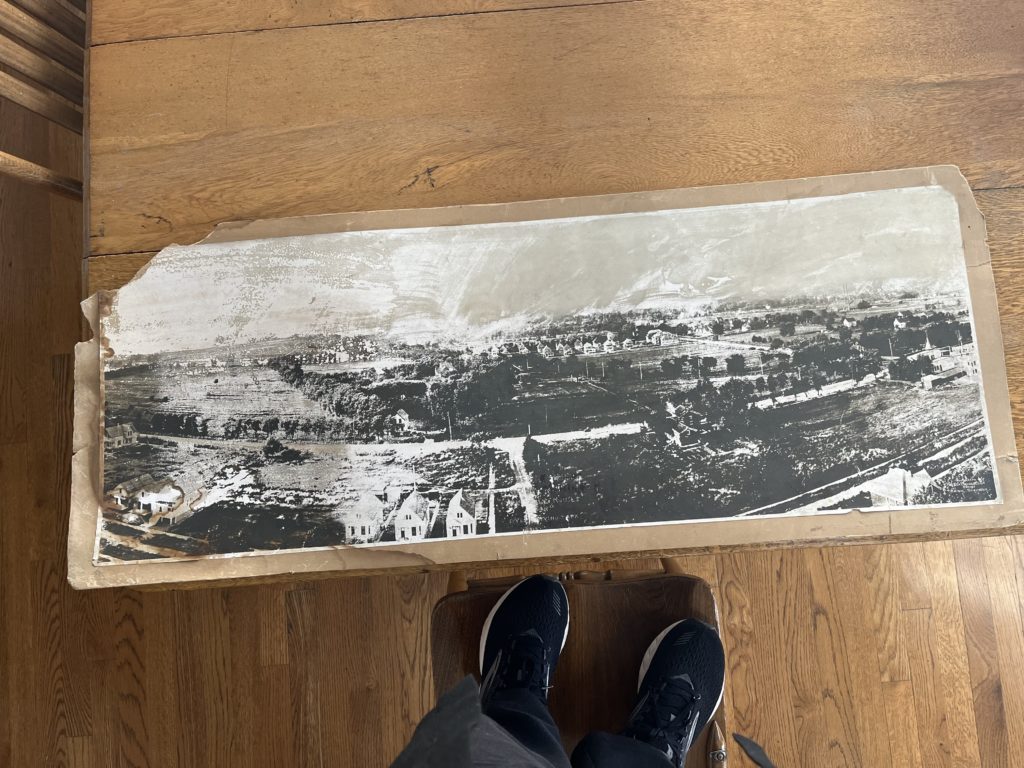
Holy smokes! I better start wearing Depends because I peed my pants again when I saw this. The photograph was taken by George R. Lawrence!! AWD used the BEST and most renowned aerial panorama photographer of that time to take a picture of our humble neighborhood. A rather “modern” and innovative move by AWD. That makes the photo even more significant and extraordinary, as far as I am concerned.
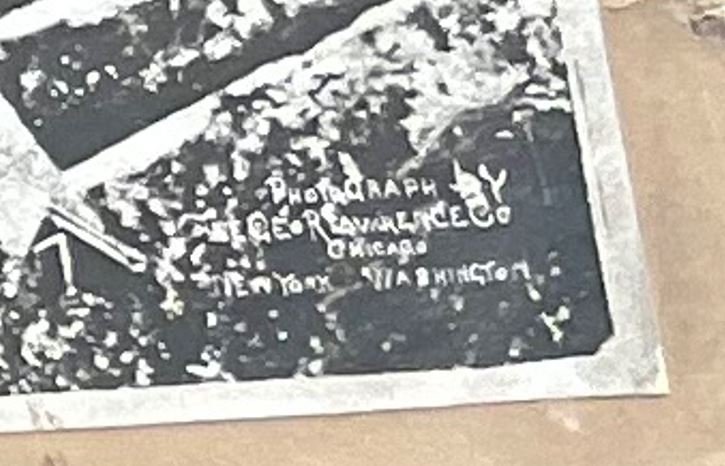
George R. LawRENCE
Knowing that the photographer is Lawrence pretty much confirms that the photo was taken using kites. Though Lawrence initially used hot air balloons for his aerial photography, an accident in 1901 while photographing the Chicago Union Stock Yards from a balloon rattled him, leading him to further develop and refine the use of kites.
“the hitherto impossible in photography is our specialty”
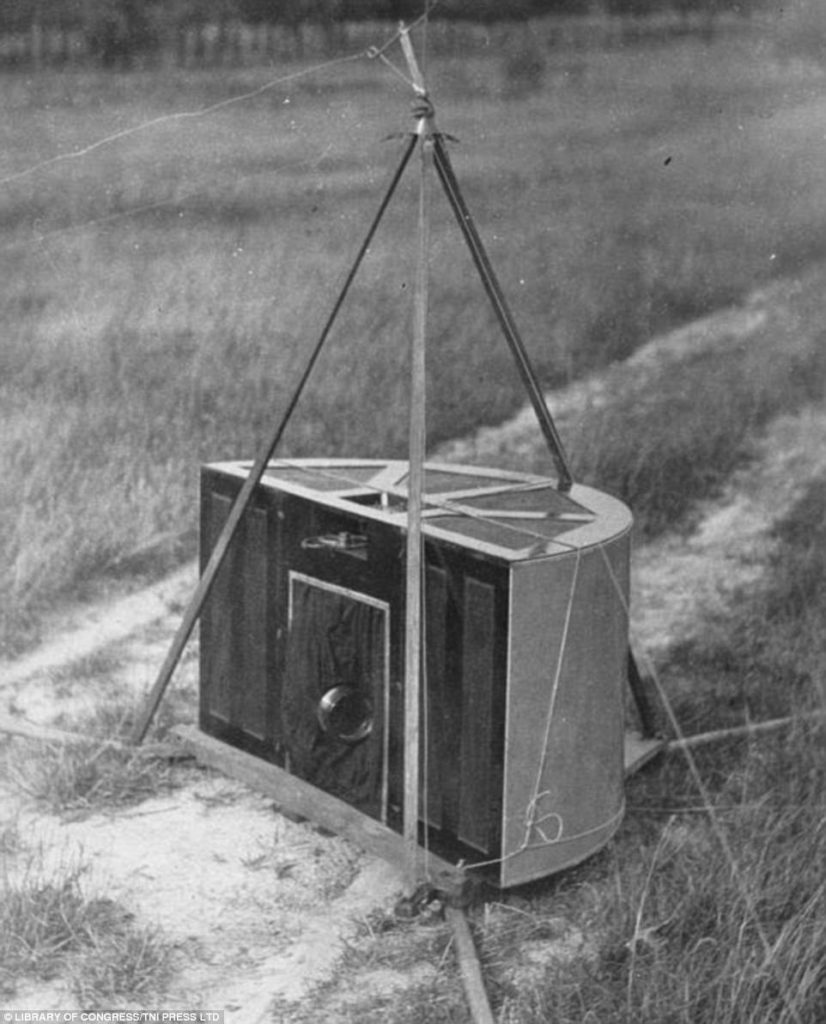
Lawrence designed and built his camera to take the panorama photos. The film plane was curved and the average negative size measured about 22″ x 48″. The camera weighed 49# and was hoisted by up to 17 Conyne kites strung with piano wire. He called his creation the Lawrence Captive Airship.
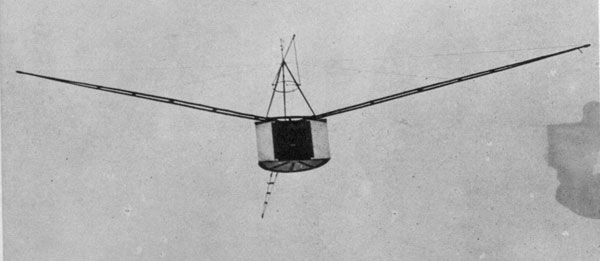
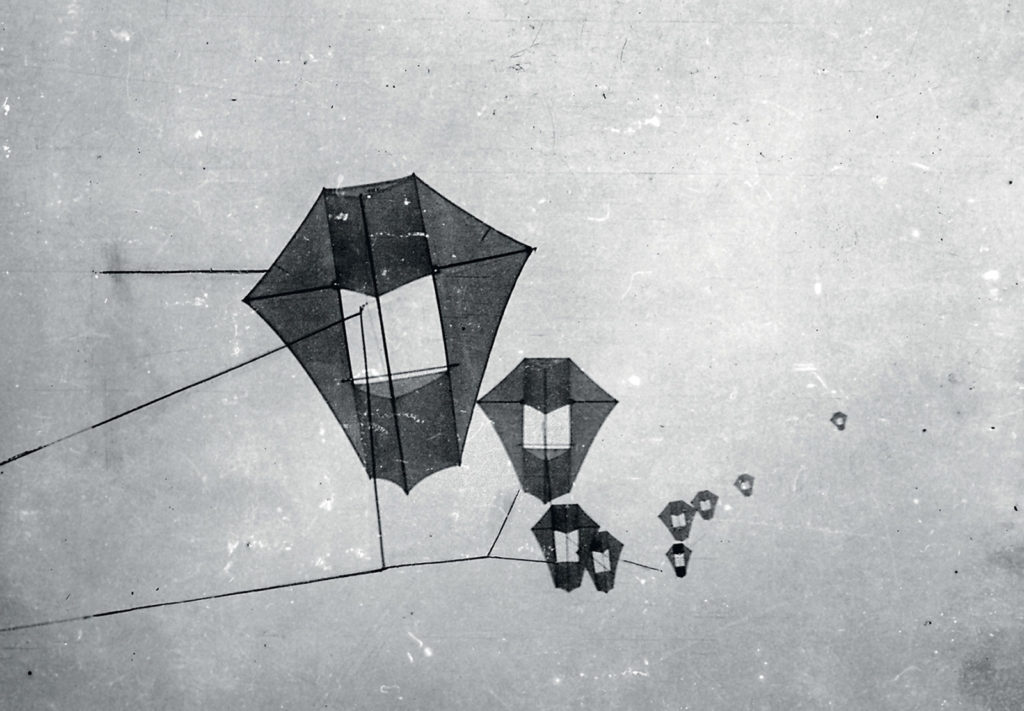
Binoculars were used from the ground to determine the position of the camera and lens. The spring operated shutter was released from the ground by a current transmitted through the metal kite line from a battery activating a solenoid in the camera. A device within the camera then swept the lens across a 90-degree arc to expose the image on the negative (thus the curve of the image). A small parachute would be released to indicate that a picture had been taken, and Lawrence hauled down the kites so that the camera could be reloaded. It took about 1 and 1/2 hours to get set up and take one picture. A day with some wind but not too much was required.
Lawrence sold prints of his 1906 SF earthquake photos for $125 per print- approx. $4000 each today. He is said to have made $15,000 from the sales on that photo alone, which would be equivalent to about $450,000.00 today. (View SF image here.)
I wonder how much this cost AWD. I wonder how many shots were taken during the photo shoot. Did Lawrence charge a “day rate” or a per print rate? If there was a per print rate, is that why there is only one full size copy to be found? Did AWD have the full size print photographed right away so that he could generate more copies?
Since we know that the Chicago Public Library has a copy of this photograph, I was hoping that maybe they have a really good quality or, even better, an undamaged full size version – and maybe some additional notes and information. I contacted the Special Collections Division and they were kind enough to send me a picture of what they have. OK, it’s basically what I believe to be a photograph of the original photograph – same as what I received from Bennett. I made an appointment to go see it anyway. Yes, it’s essentially the same size image that I received from Bennett, and the quality is not better. I was allowed to take pictures with my cell phone, but was not allowed to remove the photo from the sheet protector, so I was not able to avoid glare and reflections.
And there were no additional notes, information, or insights about the image. Oh well, I tried.
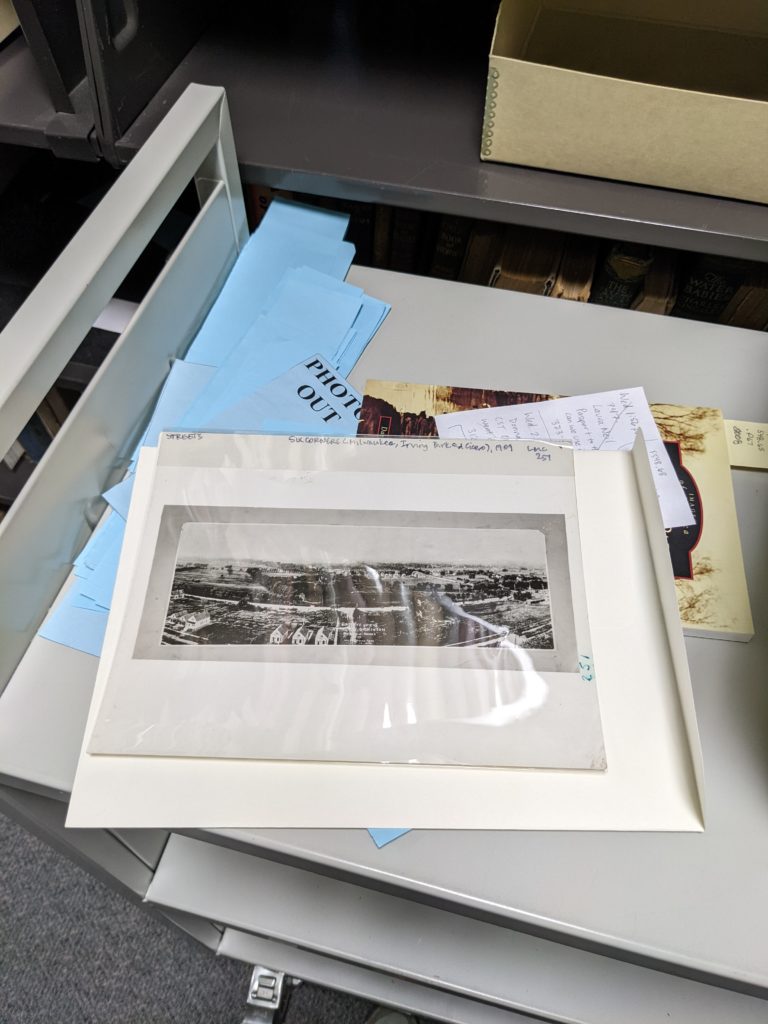
But, I’m not done yet….
The date Dilemma
I am really having a hard time reconciling the date of the photo. This shouldn’t be a question – it says “Taken in 1909” right on the image. Why am I questioning it?
Remember, I’ve documented permit dates for almost all of the houses. I can clearly see the houses built on the north side of Warner in 1906 in the picture – it’s almost a perfect match with my records: 8 houses on every other lot. Houses built in 1907 might be there but are possibly obscured by trees – like on the 5000 block of Berteau. Where are the houses that were built in 1908 and in process in 1909? Do you see them? I don’t. Shouldn’t we see some evidence of excavation, sewer and water install, paving? Per the 1910 census people were already living in houses that are not evident at all on this image. Why does this not make sense?
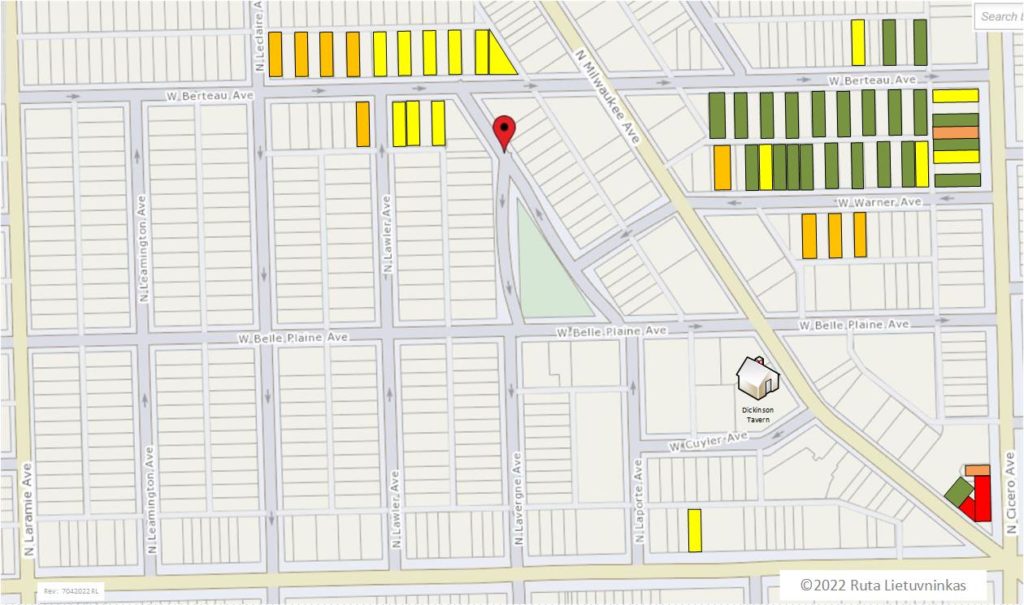
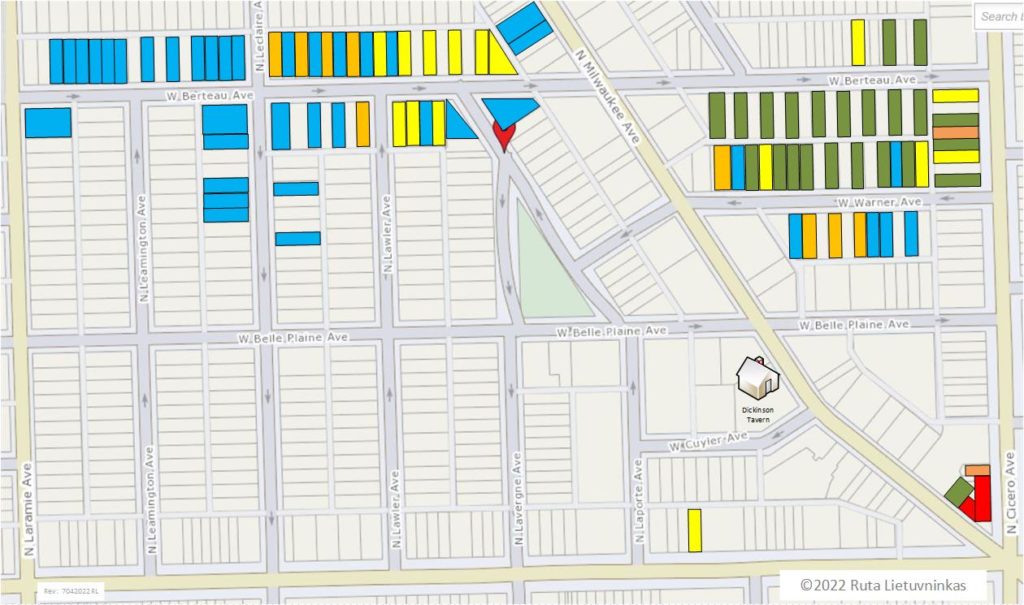
Once a permit was pulled, building usually started right away. Construction was typically completed in 3-6 months.
Observation: Because the trees are fully leafed out, the time of year must be late spring or summer. In 1909, George Lawrence was on his way to Africa by the end of August. Therefore, the photo would have to have been taken sometime between, let’s say, May and mid-August of 1909. It seems to make more sense that the photo was taken in 1908.
One other inconsistency: AWD’s company was called Reliable Homes, not Reliable Houses. Another mistake?
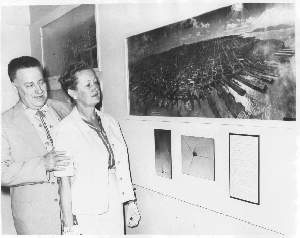
The Chicago Historical Society had a George R. Lawrence exhibit in 1960, so I reached out to them to see if they might have some insights. They have over 100 Lawrence prints and photos in their collection (but not the AWD photo). Did they possibly have the original negative or know where it is? That might provide some information. Were they interested in my question about the date? Nope.
Photo caption: The fabulous photograph on display at the 1960 exhibition of the work of George Lawrence at the Chicago Historical Society. His son and daughter-in-law are looking at an original contact print. CHS
I also reached out to Dan P., one of the authors of the Portage Park book, who referred me back to the Chicago History Museum.
Sharon Johnson had a great idea to search for newspaper articles about the taking of this AWD photo – that had to be a newsworthy event and would totally confirm or refute the date. I came up empty searching on newspapers.com.
Perhaps a local paper that no longer exists, like the Northwest News, wrote a story. I reached out to Nadig Newspapers for advice and assistance. Nada.
There is writing on the back of the full size image that simply says: Arthur W Dickinson, 3643 Milwaukee Ave. AWD’s real estate office was at that pre-1909 address (4003) until he built his new office at 4017 in 1910.
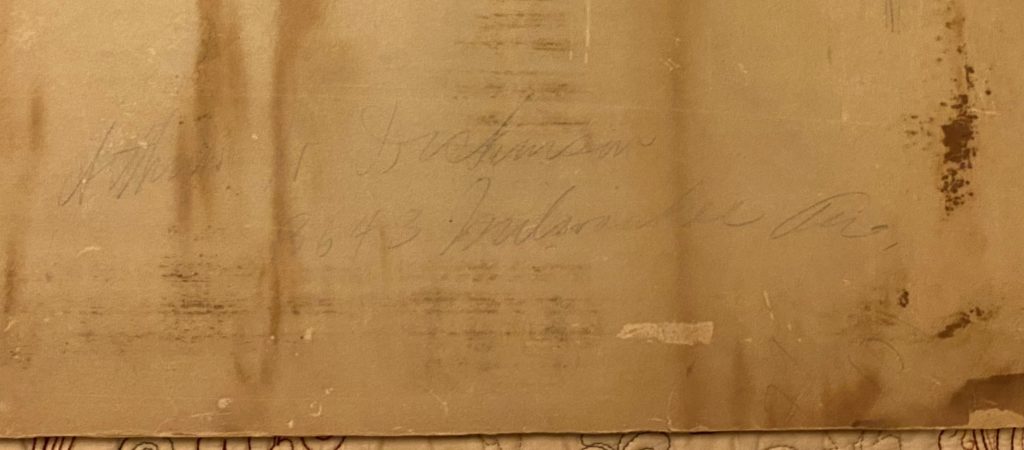
For now…but maybe more to come…
OK, in the grand scheme of things, the year that the photo was taken is not important. But on the other hand, it is, because how do we determine exactly what we are looking at. A date inaccuracy makes other investigations, documents, and facts suspect or confusing. What could possibly be the reason for altering the date of the photo if indeed it is not the correct date? “Typo”? Marketing reason? Did something happen to halt all construction for several years, like the Depression of 1907? Could it be that the photograph was taken earlier and then released in 1909?
So, I’m not done yet….more investigation required!
related and Unrelated George R. Lawrence additional info
As always, while researching, you run across all kinds of tangential information that can be quite interesting. When it came to George R. Lawrence it didn’t take much to find scandal, infidelity, divorce, kidnapping, bribery, forgery, assault, “happiness cults”. At least read the short Happiness “Oozes” out of Her article – it’s amusing.
Links to Lawrence articles:
- George Lawrence & His Aerial Photos (robroy.dyndns.info) – general short history of Lawrence’s photography
- CABINET / George R. Lawrence, Aeronaut Photographer (cabinetmagazine.org) – good article with a great photo of the mammoth camera
- George R. Lawrence took photos of US with first ‘drone’ | Daily Mail Online – article with other examples of Lawrence aerial photos

You never know what you will find when you look!


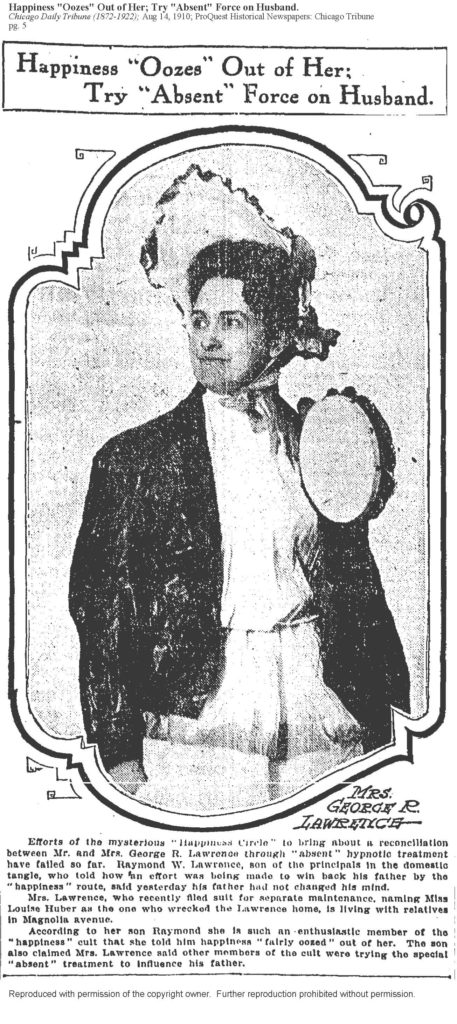
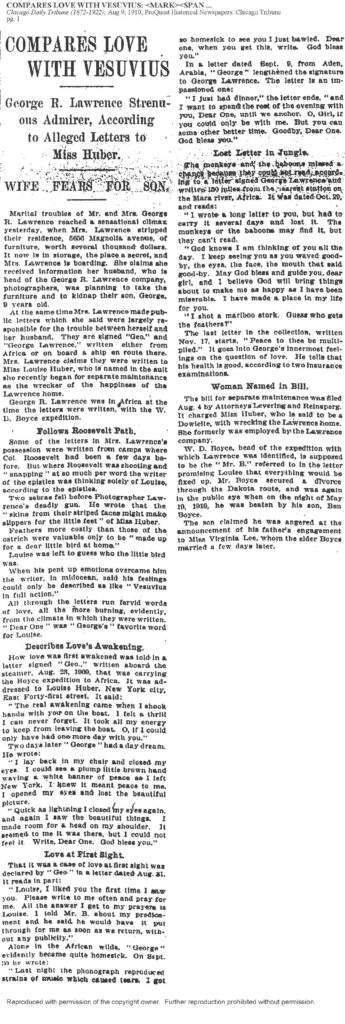
Holy smokes! Too much information for me to process! I think I need Sherlock Holmes!
“Elementary my dear Watson”
Great job Ruta! Mega interesting! Thank you so much for all you do!
Ms. Lilly
5029 W Berteau
Thank you for all of your hard work Ruta! You’re research is impressive and exhaustive and I know that we will know all that there is to know about the first chapter of our neighborhoods story.
I love the details of the arial rig!
George & Heidi
Wow, incredible information, who would have believed that kites are just for kids!!
Fascinating! You are a remarkable detective as well as journalist! Enjoying this so much!